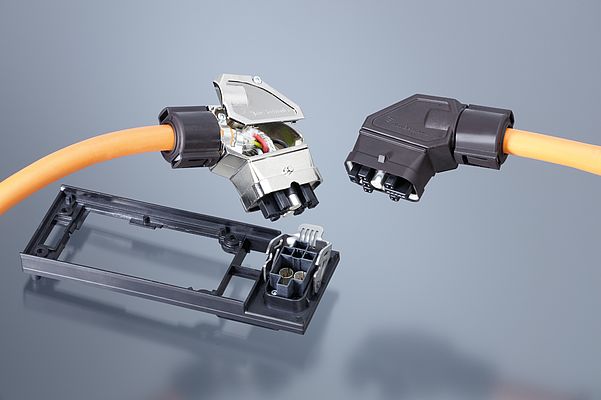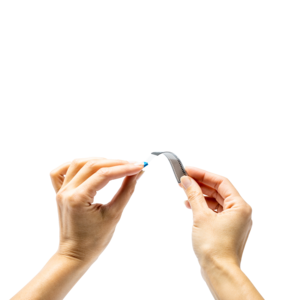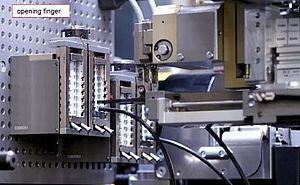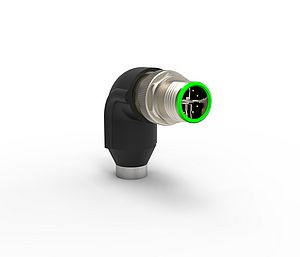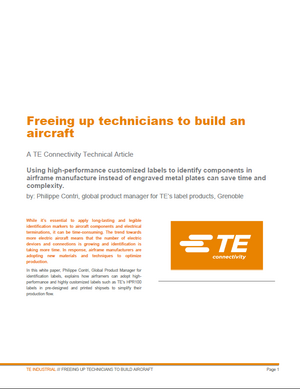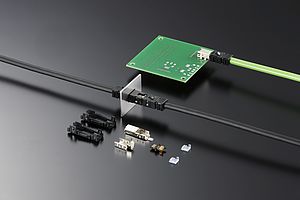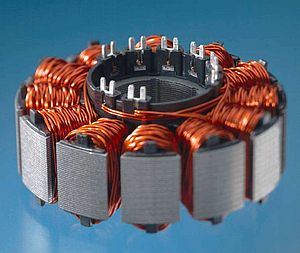The new Motorman hybrid connector from Tyco Electronics simplifies the connection of power and signal of locally controlled motors. It integrates communication, signal and power transmission within a compact single connector and therefore requires only one cable for connection. The hybrid connector features two fast Ethernet interfaces providing the full benefits of real-time automation control. The device also offers space for five power sockets, five signal sockets and one protection-earth-contact.
Servo drives (consisting of servo motor and control) are widely used in many industries. Locally controlled motors – with integrated control PCB – are the preferred technology in field automation, if many positioning routines need to be carried out with high accuracy or if many individual actions have to be coordinated in a time sequence. Up to now servo motors have typically been connected via a deterministic bus system (field bus/Profibus standard protocol) and are power-fed by a separate cable. Recently, servo motors have become increasingly networked via fast Ethernet (100 Mbit/s) as this offers the safety benefits of powerful real-time control. However, this does not solve the nuisance of having dual cabling for signal and power.
Cooperating closely with customers, motor experts and standardization committees, Tyco Electronics has developed a sophisticated connector system, which integrates signal and power supply within the dimensions of a compact rectangular connector. Named Motorman, the new hybrid connector offers space for two fast Ethernet interfaces, five power sockets, five signal sockets and one protection-earth-contact. The housing was developed completely from scratch and is available in a metal or a plastic version. The metal housing is good for tough industrial environments whereas the plastic housing is very cost-effective for less demanding environments.
Orientated to the voice of the customer
Customer requests during the last two years provided the starting point for the development of the Motorman hybrid connector. Tyco Electronics began the project at the SPS/IPC/DRIVES tradeshow in Nuremberg (Germany) in 2009. During intensive customer talks the company analyzed the „Voice of the Customer“. It transpired that the requirements suggested a compact and economic solution for the cabling and assembly of servo motor interfaces. To translate the list of requirements into a connector design, the company combined expertise from various areas within a 20 strong project team, incorporating know-how from the divisions Industrial, Automotive and Aerospace, Defense & Marine.
Compact dimensions
One of the biggest challenges during the development process of the hybrid connector was to adhere to the compact dimensions of a rectangular connector measuring just 41.5 x 22.3 millimeters. The housing and contact insert had to be fully downward compatible with the Tyco Electronics industrial Q product series. At the same time, the complete power supply and signal communication had to fit within the tight limits of the insert area. Using regular contacts, the connector would have measured twice the targeted size. The dense design could only be realized using the highly modern MCON system of receptacle contacts: The Motorman socket insert holds up to six stamped and cut MCON 2.8mm contacts for the power supply and protective conductor (equipment grounding conductor), five MCON 1.2mm contacts for unshielded signal transmission plus two shielded Power4Net fast Ethernet sockets. Hence, the interface is actually a triple hybrid combining two different signal types with power.
New housing for easy assembly
The connector housing (hood) was developed completely from scratch. Its design and assembly strategy follow the requirements of hybrid circular conductors. As cables of this type are stiff due to the wire bundling, shielding and multiple insulations, the housing follows the natural bending geometry of the assembled cable. In contrast to traditional rectangular connectors, the cable does not enter at a right angle but at 100° instead, in order to ensure a good match of cable bending radius and housing geometry. An additional support in the upper area of the bend radius absorbs further mechanical load from the circular conductor. This design avoids excessive bending angles at the beginning of the stripped wire section and makes sure that the contacts are positioned straight in their cavity. Ethernet sockets in particular benefit from this as the fully shielded spiral-four CAT5e cables will respond with increased damping, if the bending radius is too small.
The connector housing is locked onto the motor PCB by a guided lever. As the pins for the lever are positioned in the middle of the housing, the side from which the lever is operated may be freely chosen. The lever is easily opened from the side of the assembly, while it takes a screwdriver to unlock it from the other side (to prevent unintended operation). As the contact insert can be rotated by 180° the cable can exit in two directions. To ensure this level of freedom it was decided early on during the development to place the Ethernet core in the middle of the insert. Thus the bending radius of the Ethernet wires always remains the same.
Despite the dense contact packaging in a confined space, the new connector is more easily assembled than many larger rectangular connectors, because it features a spacious side access to its interior. Once the housing lid and integrated o-ring seal are removed, the individual wires are easily inserted into their chambers holding the sockets: the opening provides a direct line of sight to the sockets. The side access does not only improve assembly, it also makes it much easier to locate faults. If there are any issues in the field, every single contact can be individually checked for throughput. Depending on the level of EMC requirements, the housing is available in either a metal or a plastic version. The metal version has an additional protective conductor. When the socket insert is pushed into the housing from beneath, it will lock there via a small lug once the lid is replaced and screwed onto the metal housing version or clipped on to the plastic version.
Patented cable seal
The cable jacket seal is yet another innovation. It generates two ring shaped lines of compression around the hybrid cable jacket. As the cable is held straight between the two sealing elements, the level of compression is very equally distributed around the jacket circumference. The optimized design permits it to assemble cables of between 13 and 17 millimeters diameter with one size of seal. As the seal is held in place by a latching protective cap, the assembly can take place without a torque-controlled tool. Following detailed testing, related seal designs from the same product group have been automotive-approved to ingress protection level IP 69K.
There is a clean separation between the cable strain relief function and the seal itself. Instead of a traditional threaded cable gland cap, a metal clamp fixed with screws serves as strain relief, a design that ensures a high cable-to-plug tensile strength of >150 N. At the same time the clamp band practically provides a 360° umbrella cable shield contact.
Variable contact system for power and signal
The connector‘s socket insert offers a certain level of variability to cope with differing requirements as the insert can be selectively configured. Within power supply the possible uses range from the typical low level of 24 VDC up to 600 VDC. Tyco Electronics has released the connector for this DC voltage level and up to 20 A current at temperatures of up to 80°C. However, an AC supply with up to 480 VAC is also possible by using three to four power contacts. Following intense discussions during the design phase, all applicable European standards and UL/CSA guidelines for clearance and creepage distances are met. Tyco Electronics will cooperate closely with customers during the UL certification of an installation.
If a servo motor application for instance demands system integrity of the connector system due to product liability concerns, massive coding lugs can be added to the insert with only minimum effort for changing the injections molds. This will prevent the mating with unapproved connectors. Currently there are nine insert variants with individual facial topography of the termination side.
In addition, the hybrid connector is future-proof. As the housing and contact insert are downward compatible, they can be used for conventional field bus systems and can still be upgraded by changing the contact insert and the resulting connector front pattern if for instance industrial Ethernet is introduced for automation purposes.
Industry-grade Ethernet connection
To meet the tough real-time requirements of Ethernet communication, Tyco Electronics has chosen technology from the Aerospace, Defense & Marine field and adapted it. In the aerospace industry, Quadrax sockets serve to transmit Ethernet signals. Modified sockets of this type are used in the Motorman connector – it is the same type of socket that is also used for Tyco Electronics’ Power4Net 8+4 hybrid connector. In contrast to the Tyco Electronics Quadrax product sockets, however, only the Power4Net contacts are gold-plated instead of the complete socket, which makes it an economically viable signal transmission component, tailored for typical professional industry use, while based on aerospace expertise.
The connector also offers variability when used for Ethernet cabling. For instance it is perfectly possible to use only one of the Power4Net sockets and close the other during assembly. However, using both Power4Net sockets offers the advantage of being able to connect several servo drives in a daisy chain, which helps to meet even the highest standards of redundancy in controlling the motor.
Engine side – male contacts for optimal PCB placement
The pin housing designed for mounting on the servo motor PCB was also extensively optimized for this application. Firstly the low-height solder pins have very little mass and are tailored for automated reflow soldering at 270°C. Secondly the signal and power pins are placed and grouped on either side of an integrated barrier, to optimally support an engine PCB layout strategy that fully separates signal trace from power. Therefore signal and power paths do not cross which means that the PCB needs fewer layers. Again, this design detail can be traced back to many meetings with customers and subsequent targeted development.
As economic as a discrete solution – but more efficient
The hybrid connector offers a wealth of function within a compact area. Still it is easy to assemble as the housing design provides optimum access to its interior. As the assembly of a single rectangular connector can take between half an hour and a full hour (if you calculate from cable stripping right through to final testing of the assembly) there is a clear potential for improved efficiency. Realizing this potential means reducing the assembly effort per motor and simplifying the cabling.
The modern MCON contact system, which has enabled the dense contact packaging despite the confined space, is a very mature technology that ensures signal and power integrity despite vibration and shock. Being in essence a standard contact system it also offers the freedom to chose the contact plating as best fits the application. A complete range of assembly tools is available as well.
The comprehensive Tyco Electronics know-how facilitates a high level of vertical integration which includes injection molding, stamping and bend forming. Thus a permanent and consistent optimization on all levels of connector technology is possible. Despite being state-of-the-art technology, the connector is also downwardly compatible which makes it an immediate option for many purposes while protecting investments: the device is future-proof and can be upgraded at any time.
Author: Achim Pfeffer, Product Manager Tyco Electronics



